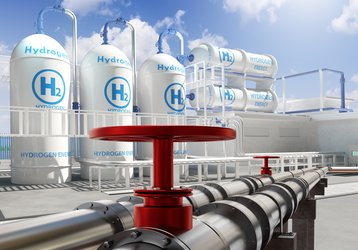Hydrogen, biogas, e-fuels, hydrotreated vegetable oil (HVO). There are multiple greener power alternatives, especially for backup, but there’s a lot of devilishness in the details that need to be mastered before organizations like data center operators make their next steps in sustainability.
“As an organization, we have to look at alternative fuels. The majority of the installations that we've delivered over the years are primarily natural gas-fueled installations, but there are also an awful lot of renewable gas applications,” said Adam Wray-Summerson, a project/product development manager at Clarke Energy.
Now, the data center sector and other customers are demanding technology roadmaps to help them plan out their decarbonization journeys – with some already pledged to achieve net-zero by 2030 – and that’s putting pressure on companies like Clarke Energy and INNIO to come up with solutions.
Indeed, one route that has arisen in recent years is the shift towards renewable gas: at the moment via hybrid power solutions, in order to maximize renewables; but, later, with alternatives such as green hydrogen – hydrogen fuels generated using renewable power – feeding in.
“Biogas might not be the solution, but is potentially a renewable fuel that could add value,” said Thomas Seeber, sales and commercial operations director at INNIO Group. INNIO has been involved with some 10,000 biogas applications around the world, and biogas could also be used in the data center sector as a more environmentally friendly alternative to diesel, not just for backup, but also primary power.
Seeber and Wray-Summerson were speaking at the recent DCD>London event.
“There’s not one solution,” cautioned Seeber. For some clients, he added, shifting from diesel to hydrotreated vegetable oil (HVO) is the most sensible next step, while biogas is a good option if it is locally available. “It often depends on the local infrastructure and the supply chain, because biogas is not made for long transportation; they should be produced as near as possible when they are consumed,” he added.
Storage is not a straightforward issue, either, especially for hydrogen-based fuels. “So, therefore, there is not one answer. There will probably be a mix. Personally, I think that hydrogen has a certain value, but the question is when and where will it start? Will it really be in the data center sector? Will it be an e-fuel, like ammonia (NH3) or methanol (CH3OH) and, if so, maybe that’s more for the automobile industry to decarbonize existing engines,” said Seeber.
He added: “There’s no clear answer, but I think the various options should be assessed on a case by case basis.”
Indeed, the production of hydrogen requires both an input, as well as electrical energy: if the input is natural gas to produce ‘blue hydrogen’, only to use that hydrogen in place of natural gas the sustainability case is solidly negative, even with carbon capture (which also adds to the cost). Green hydrogen, meanwhile, has its own cost and volume issues that need to be overcome.
More...
-

Clark delivers data center to NTT in Ashburn, Virginia
Sixth of nine planned buildings nearly complete
-

DCD>Talks Energy Resilience & the Hydrogen Future with Clarke Energy & INNIO Jenbacher
In this DCD>Talk we sit down with Alan Beech, Clarke Energy and Thomas Seeber, Innio Group, about the future with Hydrogen
-

The pros and cons of hydrogen
Is hydrogen the only reasonable option for the future?


